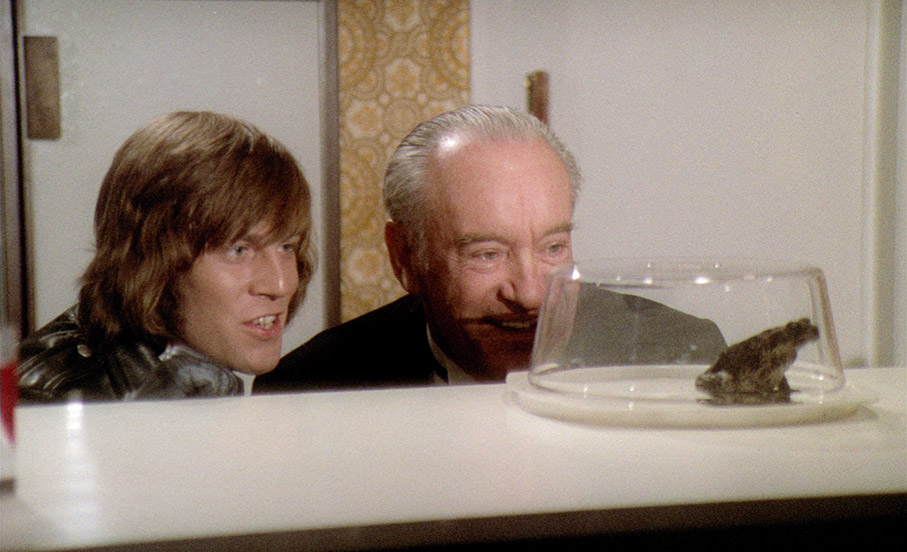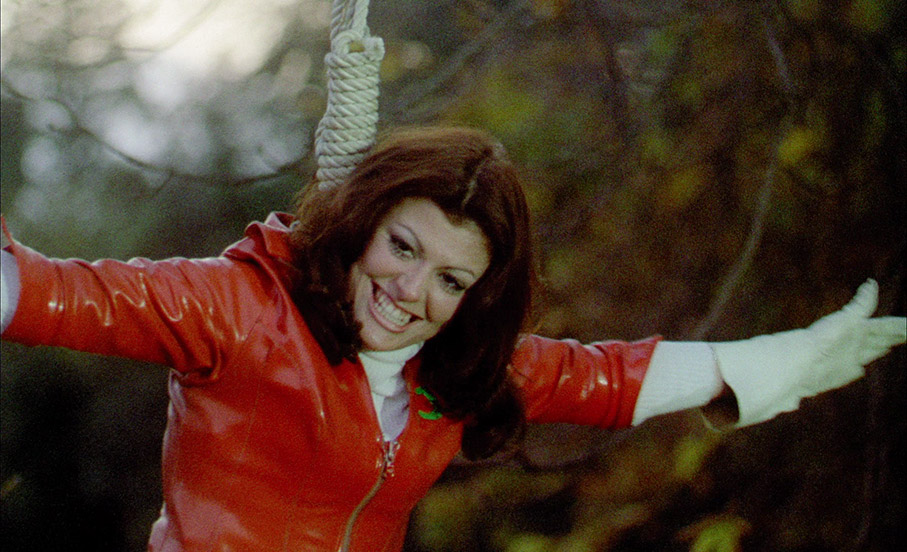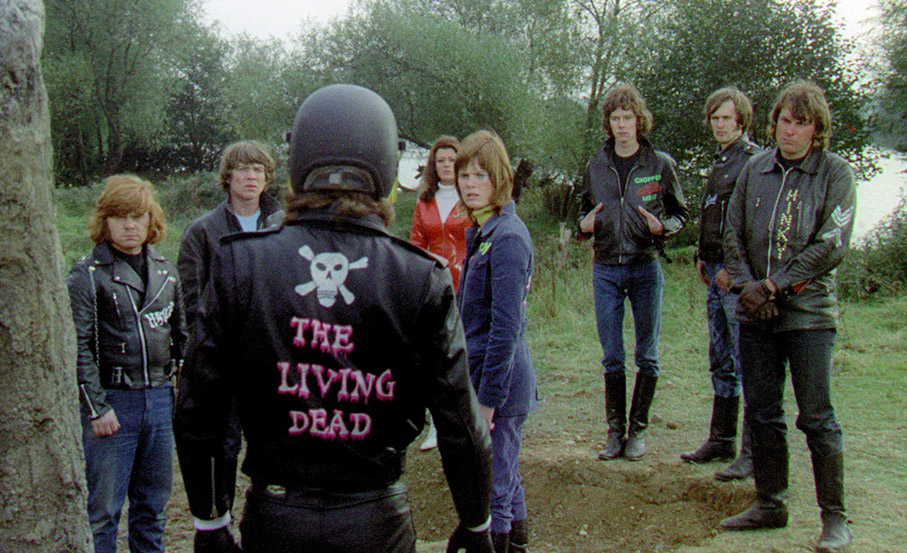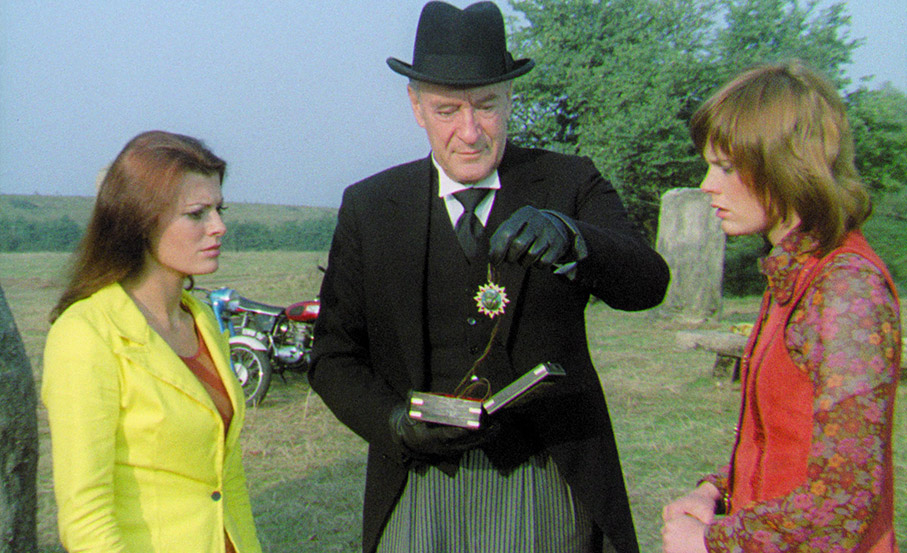|
It's always rather lovely when a film quietly sideswipes you in its opening ten minutes by playing games with your preconceptions. Take the colourfully titled Psychomania, the latest release from the BFI's excellent Flipside strand. Following a title sequence that tells us more than we initially realise, in which faceless bikers ride around a misty stone circle site known as The Seven Witches in portentous slow motion, we watch them give a motorist a fright by driving straight at him and forcing him to swerve. "Shall we let him go?" asks smiling gang leader Tom (Nicky Henson) of his equally amused troops. "No," pipes up Jane (Ann Michelle), his red-jacketed second-in-command, "teach him a lesson." "Yeah," adds the intriguingly named Chopped Meat (Miles Greenwood), "Blow his mind." Tom and his slightly more hesitant girlfriend Abby (Mary Larkin) thus head off to repeat their earlier game of chicken with the car, but this time the driver's evasive action throws him through the windscreen. A short while later, Tom is making out with Abby in the local graveyard. Oh let's not be coy, they're snogging on someone's grave, their helmets casually hung on the cross-shaped gravestone. This all comes to a halt when Tom spots a large frog, which he stealthily captures and tucks into his jacket. Abby is understandably ticked off with this behaviour. It's then that Tom revives the notion of the two crossing over to the other side by killing themselves. "Not that again," laughs Abby, who's clearly heard this a few too many times before.
It's an opening five minutes that appear to dress its youthful lead in a familiar coat of sub-genre cliché. Tom is clearly a young tearaway with little concern for the lives of those who are not part of his biker brotherhood, and he and his companions have an almost adolescent love affair with the iconography of death – the gang goes under the name of The Living Dead, their helmets are painted with skull motifs, and he likes to get his rocks off in a graveyard and fantasises about suicide. And his gleeful grabbing and pocketing of a frog marks Tom as a bit weird, so he's probably capable of just about anything if pushed. Adding a layer of artificiality to the mix is that Tom has the sort of cultured voice that marks him more as a trained actor than a genuine biker. Such are the perils of film casting before directors had the likes of Phil Daniels, Ray Winstone and Phil Davies to draw on.

Yet in the very next scene, this rash supposition is neatly undermined when Tom returns home to the country estate of a house in which he happily resides with his clairvoyant mother (the wonderful Beryl Reid) and their faithful butler Shadwell (the velvet voiced George Sanders in his final film role). Given his background, it turns out that Tom's accent is right on the nose, and I began to wonder what other surprises lay in store. Quite a few, as it happens. When Tom walks in, his mother is conducting an authentic-looking séance for a group of guests, putting a woman in touch with her deceased young daughter, in whose voice Tom's mother is speaking. Tom leaves her to it and heads into the kitchen, where he places the kidnapped frog under one of those glass containers used for storing and displaying delicious cakes. What a prankster. We can only imagine the shock it will give his mother or Shadwell when the stumble across it. Yet when Shadwell walks in and eyes Tom with a look of stern disapproval, Tom nods towards the frog and Shadwell responds with an expression of undisguised delight. Tom shares his enthusiasm for the find and even knows the Latin name for this specific species. The surprises continue when Tom pops in on his mum, the guests having been loudly ordered to bugger off by Shadwell after offering a jewelled crucifix as payment for a successful séance. After a cheerfully genuine "Good evening, mother," he accepts her hinted request for a dance, during which she casually questions him on what he and his gang have been up to and warns him of the prospect of impending arrest, all without breaking her smile for a second, while Tom offers some hip corrections to her diction ("The word, mother, is 'fuzz'"). What, exactly, is going on here? Twelve minutes in and I was already hooked.
But writers Julian Halevy and Arnaud d'Usseau (the team behind the previous year's Horror Express) and director Don Sharp (whose filmography includes personal favourites Kiss of the Vampire and Rasputin: The Mad Monk) are just getting started here. Tom starts questioning his mother and Shadwell about the finality of death in a manner that suggests they know something about escaping its clutches, something our Tom seems desperate to share. Initially reluctant, eventually they relent and give him a protective amulet (one bearing the image of a frog, no less) and the key to a room in which strangeness runs rife, trapping the increasingly terrified Tom inside and hitting him with sacrificial visions, which eventually knock him cold. He wakes with the certainty that if he takes his own life and really wills himself to return, then he will rise from the dead blessed with immortality and invulnerability, something he puts to the test by terrorising locals with the rest of the gang and then driving off a bridge and into a river. When his body is discovered and his death is confirmed, the unknowing Abby pays a visit to Tom's mother to request that the gang be allowed bury him in their own specific way, at The Seven Witches site that has become the gang's favourite meeting spot. As burials go, it's a memorable one. Serenaded by Chopped Meat and the sort of folk song that wouldn't have been out of place in The Wicker Man (a rather good one, as it happens), Tom's corpse is placed in a grave dressed in his leathers and sitting on his bike, but at a depth that would leave his head above ground level, which is presumably why the gang – who in this one scene have been transformed from bikers into hippies – has to pile so much earth on top to cover him. Before they do so, Shadwell rolls up in the family Bentley to drop the frog amulet into his grave. A short while later, a stranded motorist is taking a reluctant short cut through The Seven Witches and witnesses Tom driving out of his grave at full pelt (this is really well done) and is run over by him.

The film has some dark fun with the resurrection process, as Tom blags some change from a flirty girl in a pub to phone home, and responds to his mum's delighted enquiry about his health with a cheery, "Well, I'm dead, mother, but apart from that I couldn't be better." The promise of immortality meanwhile prompts Jane to enthusiastically follow Tom's lead and rise from the dead to be by his side, which she celebrates by hanging herself by the neck from a tree branch in Abby's garden just to watch her reaction. These intermittent but memorable snippets of black humour reach a genuinely funny peak after Tom has convinced the rest of the gang to follow in his resurrection footsteps, and the carefree Chopped Meat leaves his bike in a No Parking zone and makes his way into an adjacent tower block; when he looks down and sees a beat policeman writing him a ticket, he calls out to him from a seventh floor apartment and is ordered to come down, an order he cheerfully complies with by climbing through the window and plunging to his death.
I'm not sure whether writers Halevy and d'Usseau took on the challenge of making a biker horror movie to test their own creativity or in response to a commission from others, but either way they did an inventive job, and director Sharp was clearly determined to do right by the material and takes his job as seriously as he would have for a prestige mainstream thriller. This is particularly evident when the bikers hit the road, where Sharp seems to relish the opportunities that pitting bikes against cars present for the willing filmmaker. He stages the police chases and the bikers' dangerous game-playing with other road users with real cinematic flair, picking his angles well, travelling with the riders and even bolting the camera to vehicles to involve us directly the action. I'll bet these scenes were as exciting as hell to watch on the big screen. Sharp also sidesteps just about every opportunity to trade on the violence that unleashing a biker gang that lives up to its chosen moniker on an unknowing public must have presented, opting instead to show the consequences of their actions rather than the acts that brought them about. And there's some real wit at work here, which peaks in a slow 360-degree pan of a morgue in which a trap has been set for the bikers, where policemen seen readying themselves at the start of the shot are revealed at the end to have been silently disposed of and placed in the glass-doored compartments in which bodies awaiting autopsy are stored, still dressed in their uniforms and wearing their helmets.
Maybe it's because I used to hang out with bikers and still regard them as kings of the road, but I found it easy to warm to the members of The Living Dead, while their reckless driving and intimidation of motorists (and at one point, passengers) has an engagingly rebellious air of a low level The Wild One or Sons of Anarchy about it. Even when they go on the rampage in the local town centre, charging through a shopping centre and forcing pedestrians and shoppers to dive for cover (oh come on, we've all done it), I was still on their side – it's perhaps for that reason that the game is upped later when they drive their bikes into a minimart and, in a move that I genuinely did not see coming, cap their invasion by driving straight at a pram and sending it sprawling, presumably killing the baby being carried within.

While it seems likely that Tom and his newly undead companions will come a cropper before the film's end, it's to the film's credit that we're late into the story before any hint of how this might be brought about is revealed. The process by which resurrection is achieved is also kept usefully oblique, dancing with the Devil without saying his name and avoiding the standard horror movie occult clichés by audibly drowning out the specifics of incarnations, and by rejecting genre favourites like ravens and spiders and making frogs – animals whose lineage goes back over 200 million years – the creatures from which the knowledgeable can draw power. It helps no end that such a talented cast – which includes Robert Hardy as the police inspector investigating the results of the bikers' mayhem – appear to have taken this job as seriously as they would a non-genre film, never camping up moments that offer the opportunity to do so and selling the supernatural elements as oddly plausible, at least within the framework of this particular story.
Apparently slammed by critics on its release (its IMDb trivia page claims that The Times deemed it as only fit to be shown at an SS reunion party), it will doubtless still be dismissed by some as a silly slice of exploitation nonsense (the film's then young lead still regards it as such). I, and a number of enthusiastic others, beg to differ. For me, Psychomania was a real surprise – it's smarter than its surface detail suggests, is intermittently very witty, and boasts some of the best bike action and stunt work you'll find anywhere in modern British cinema. It is thus, in this humble viewer's opinion, a most worthy title for inclusion in the BFI's Flipside collection.
This restoration of Psychomania was made from black and white separation preservation masters, which were cleaned and scanned at 2K resolution, after which digital tools used were to reduce flicker, negative sparkle and dust, and then the three masters were digitally recombined to create a full colour image, after which further grading and restoration was undertaken. The results are very impressive, though some evidence that we're watching a restoration from imperfect material is intermittently visible, largely in the area of colour stability, which can vary a little even midway through a shot. But in all other respects this is an excellent fine job, with a crisp rendering of detail, a warmly rendered colour palette and consistently well balanced contrast that strengthens a little when the light levels drop but never looks even remotely washed out. Film grain is visible, but always feels right and has not been exaggerated by enhancement. A few dust spots remain, but for the most part the image is very clean.

The remastered mono soundtrack has been rendered in Linear PCM 1.0 and is in surprisingly good shape, something most evident in the clarity of the dialogue and the music score, particularly the funeral song, Riding Free. There is also no damage or background hiss to contend with.
Optional English SDH subtitles are also available.
Trailer (2:50)
There are spoilers aplenty in this unsurprising sell that focuses on the wilder behaviour of The Living Dead and includes footage from the climactic scene and even a clear indication of what will happen to one of the lead characters at the end. Don't go near this until after you've watched the film.
An Interview with Nicky Henson (13:57)
The film's highly affable and upbeat Henson, who plays Tom, looks back at a work he still regards as rather silly, outlining how he came to the project and recalling a number of entertaining anecdotes about the production, many of which are repeated elsewhere in the extras here. This incudes his disappointment when the Harley-Davidson hogs in the script turned out to be clapped-out Triumphs, though I would argue these were at least a little more likely for a British bike gang.
Return of the Living Dead (25:02)
A look back at the making of the film, built from interviews with actors Nicky Henson, Mary Larkin (Abby), Dennis Gilmore (Hatchet), Rocky Taylor (Hinky, but also one of the film's stuntmen) and Roy Holder (Bertram). Henson's recollections are a virtual re-run of the ones from his stand-alone interview (though this was actually shot in 2010 for an earlier DVD release, so technically they're being told first here), but there is plenty of new material from the others, and their industry backgrounds alone are eye-opening – Gilmore's CV includes such luminary works as Village of the Damned, Tomb of Ligeia and Blood on Satan's Claw, while Taylor's first job was teaching judo to Cliff Richard. There are varying memories of working with Beryl Reid and George Sanders (the rumour that Sanders took his own life after seeing a rough cut of the film is repeated here), and a useful breakdown of how some of the stunt work was done, including the shopping precinct rampage. Views on the finished film also vary – Gilmore thinks its great, and it clearly found favour with bikers and Goths, but Henson admits to being "pretty ashamed" of it at the time and recalls asking the producer, "How ever did you get the finance to make this piece of shit?" All seem to have enjoyed making it, however, and are pleasantly surprised by its cult longevity.

The Sound of Psychomania (9:06)
Composer John Cameron takes us on an interesting trip through his music and film career – his first scores were Poor Cow and Kes for Ken Loach – with the emphasis, appropriately, on his work on Psychomania. He plays a bit of the main theme at the end.
Riding Free (6:25)
An interview with singer-songwriter Harvey Andrews, who performed the song Riding Free, a job for which he was paid the princely sum of £15. He's clearly not a fan of the way it was used in the film (mimed by "a pretty boy" who strums instead of plucks the guitar), but does perform it for the camera at the end and captivatingly so – Andrews' singing voice is completely different to how he speaks.
Hell for Leather (7:51)
Giving this release a completist feel is this interview with Derek Harris, the current owner of Lewis Leathers, whose reputation as the go-to shop for motorcycle clothing – much of which they make themselves – led to them being asked to provide the biker costumes for Psychomania. We get a detailed breakdown of one of their popular (and for bikers, instantly recognisable) Bronx Jacket, and this appears to be where actor Nicky Henson – a keen biker even before landing the role of Tom – bought his own gear, which he wears in the film.
Restoration Demo (1:47)
A brief look at the process of restoring the film from black and white preservation masters. I could have done with more on this.
Wilson Bros. Trivia Track
This extra plays the film with a subtitle track from genre aficionados Kevin and Nick Wilson. I'm not the world's biggest fan of these tracks as the worthwhile info is not delivered in a continuous stream and you never know how long you'll have to wait for the next factoid, and some of those you'll also find elsewhere in the extras. The useful material is also peppered with personal opinions and unfunny quips, but there is still enough interesting stuff here – on the film itself and related issues – for the patient to savour.

Discovering Britain with John Betjeman (3:17)
One of those terribly English travelogues of years past that poet and writer John Betjeman had down to a tee, this one focuses on the standing stones at Avebury, the biggest prehistoric temple in Northern Europe and still a bit of a Mecca for pagans.
Roger Wonders Why (18:23)
Perhaps to provide a counterpoint to the film's demonically resurrected bikers, this amateur 16mm production, made by the St. Andrew Young Communications Fellowship in Chelmsford in Essex, follows a devout young member of local Christian group – the eponymous Roger – as he is transformed into a rocker and learns responsibility by leading a venture scout group in North Wales. Interesting as a social and historical document – the 59 Biker Club overseen by the Reverend Bill Shergold was both real and popular – but it still gave this committed non-believer the willies.
Booklet
This typically fine booklet kicks off with an excellent fan-boy essay on the film by Vic Pratt, whose enthusiasm for it goes back many years and comes across in spades. This is followed by a useful piece on George Sanders by William Fowler, and a solid appreciation of the film by Andrew Roberts. Credits for the film and full details of the restoration are also included.
Described early on in the Wilson Brothers' trivia track as "Don Sharp's frog-worshipping biker/zombie/horror/exploitation opus, Psychomania is the very definition of British 70s cult cross-genre cinema, and way cooler and more fun that even its entertaining trailer had led me to expect. It certainly has a devoted following, and that trailer has even been recreated by one fan using the editing tools in the Grand Theft Auto V video game (you can watch it here). Those who love the film can rejoice at this release, and those who've never seen it – at least those who don't look down their nose at exploitation cinema – should take the plunge. A splendid release on every count. Warmly recommended.
|